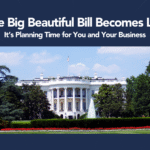
David Zaiken Featured in Charleston Magazine’s 2025 “Faces of Charleston”
July 16, 2025
One Big Beautiful Bill Act
July 28, 2025Why the Best Retailers Prepare Before They Buy

By Adam Johnson
Retailers in tourist areas are facing a one-two punch: a slower-than-expected start of the season and looming tariff hikes on imported goods. Before you attend fall trade shows to stock your store for next year, it’s time to think differently, because the same approach as last year may hurt your business.
A Tough Year Just Got Riskier
Tourism retailers, who have already purchased their goods for the season, are not feeling the tariff squeeze yet, but they’re already experiencing the strain of lower consumer spending, which means fewer souvenirs, apparel and impulse items.
Many coastal tourism retailers report that revenue is down 10% to 20% compared to last year, with some down as much as 50% from COVID-era peaks when international travel wasn’t permitted and stimulus money was there for the spending. Additionally, tens of millions of international visitors are rejecting U.S. travel, which is estimated to cost the economy $12.5 billion this year, according to the World Travel & Tourism Council, which also notes that early summer bookings from Canadians are down over 20% compared to last year.
This means that retailers don’t have much latitude to make mistakes.
The August 1 Tariff Threat
The most pressing concern? Tariffs. The initial three-month pause on proposed steep tariffs was set to expire July 9 but has now been pushed back to August 1. Letters have been sent by the Trump administration to more than 100 countries informing them they need to reach a deal or the higher tariffs announced by the president back in April will take effect. To date, President Trump has sent letters to more than 20 countries dictating that their increased tariffs would range from 10% to 35%.
U.S. tariffs on many Chinese-made goods – including tourist staples like chairs, souvenirs, swimwear and boogie boards – stand at above 30% today but could go significantly higher on or before August 12. Negotiations with China lowered the tariffs from a threatened 145% through a preliminary accord, but if the higher tariff is enacted, that could more than double the cost of importing some goods. Additionally, the de minimis rule that allowed goods valued at $800 or less to enter the United States duty-free has been terminated. These developments may create tremendous pricing and supply chain challenges.
Retailers will need to wait until the August 1 and August 12 deadlines to understand the final outcome. However, the trend is clear – tariffs are increasing.
While the tariff news is constantly changing, retailers should not take a “wait and see” approach, with the idea that new costs can be passed on to customers. It’s a bad strategy because one of your competitors may find a smarter way to source goods and sell them for less.
Some argue that the wholesaler and manufacturer will bear some of the costs, but that’s the conversation retailers must have with suppliers before the high-pressure trade shows in the fall.
Most Retailers Are Not Ready
Too often store owners arrive unprepared – ordering goods on the spot from the same vendors year after year without reviewing their exposure to risk. This year, rethink that approach and consider working with a tax and/or legal advisor to assess risk, model scenarios and prepare for critical trade show decisions.
Here’s what that process might include:
- Vendor analysis: Identify where your inventory is coming from, what the tariff might be, and how much of your cost of goods sold (COGS) is tied up in specific suppliers. Look at alternatives.
- Tariff modeling: Assess what a 100%+ increase in tariffs would do to your profit margins and how you might mitigate that risk. This analysis leads to pricing and procurement strategies.
- Inventory strategy: Plan for inventory levels and timing, and evaluate whether shifting your product mix or switching vendors could improve profitability.
- Price modeling: Test how different pricing strategies would affect sales volume and margin.
If you own a $5 million business, for example, and you miss the mark on COGS by even 1%, you’re potentially leaving tens of thousands of dollars on the table. For most retailers, the cost of modeling and advisory is minimal compared to what’s at stake.
The Cost of Doing Nothing
But even if the worst-case scenario doesn’t become reality, the exercise of preparation is still valuable. Modeling is already done by larger companies as a regular business practice, but small and mid-size retailers can neglect it when times are good.
However, when facing the dilemma of raising prices and losing sales, or absorbing costs and shrinking margins, trade show readiness is key. The most prepared retailers will get better deals and lock in inventory at the best prices.
Trade show season starts in September. If you walk in without a game plan and some flexibility, you risk falling behind. This is the year to think like your biggest competitors. If you play your cards right, you can offer reasonable prices while protecting your profits.


